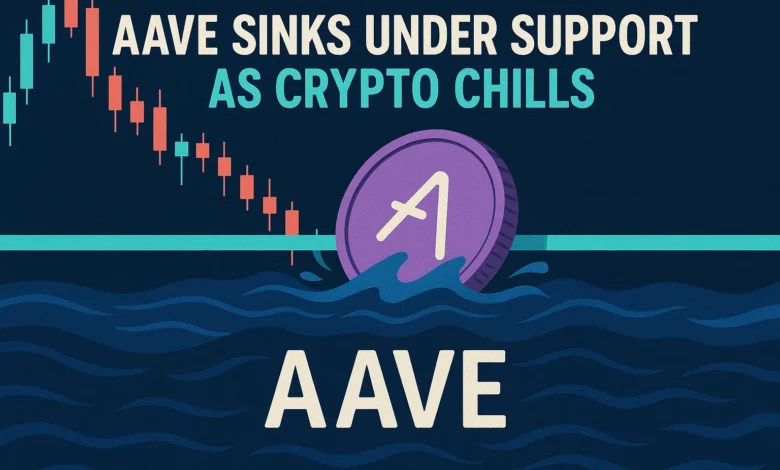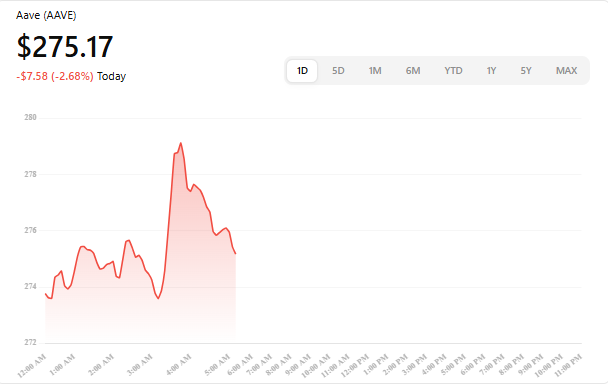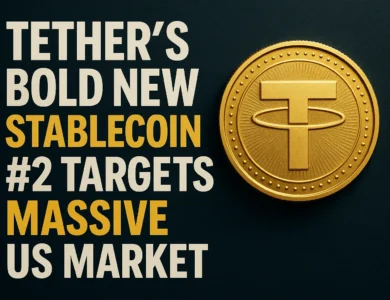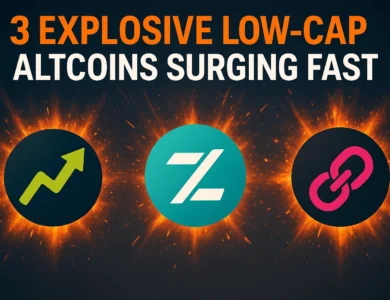
The decentralized lending blue-chip has had a rough stretch. AAVE—the governance token that powers the Aave money market—slipped beneath several closely watched supports as the wider market cooled. The move arrived alongside a softer tape for Bitcoin and Ethereum, risk-off macro crosswinds, and a brief rush of high-volume selling that pushed AAVE through bids that had been supporting the price for weeks. On October 9–10, 2025, Bitcoin and Ethereum were both in the red intraday, reflecting a broader downturn that weighed on altcoins across the board.
At the time of writing, AAVE is trading near the low-$270s, with intraday swings underlining just how jumpy order books have become. (Live price below.) The breakdown matters because it shifts the market structure from “range-with-support” to “supply-in-control,” raising the stakes for the next retest of former support—now potential resistance. CoinDesk reported heavy, institutional-sized flows accompanying the downdraft, a sign that the move wasn’t just retail panic but a rotation by larger players into safer exposures.

What happened to AAVE—and why now?
A few threads converged. First, the macro backdrop darkened, with a firmer U.S. dollar and choppy risk sentiment dampening appetite for high-beta crypto assets. Headlines through October 9–10 detailed a market-wide soft patch, with most majors down on the day and crypto-exposed equities easing. When the benchmark coins wobble, liquidity thins out on alt pairs, and structurally higher-beta names like AAVE can overreact on the downside.
Second, order-flow dynamics tipped. CoinDesk’s market desk flagged high-volume selling as AAVE slipped through critical thresholds—precisely the kind of activity that accelerates momentum through previously defended zones and flushes out late longs via forced liquidations. That combination—macro shakiness plus an order-flow shove—was enough to crack the shelf that had been propping AAVE above the mid-$270s to high-$280s.
Finally, there’s the context: just days earlier, AAVE had flirted with resistance near the upper-$280s to low-$290s after a strong September for DeFi fees and volumes (Aave was among the top earners). When momentum stalled at resistance, the stage was set for mean reversion.
The key support levels that gave way
The $280–$285 pivot turned into an overhead supply
Into early October, the $280–$285 band acted like a pivot: on the way up, it slowed advances; on pullbacks, it often caught bids. Once AAVE fell through that shelf on heavier prints, the market treated it as overhead supply—a classic polarity flip. The speed of the flip matters: when a level transitions from support to resistance in a single session on above-average volume, it often takes multiple tests to reclaim.
The psychological $270 handle flashed and held—barely
Intraday prints slipped under $270 before bouncing. Psych levels rarely “hold to the cent”; what matters is whether buyers can defend the area and absorb supply. With Bitcoin and Ethereum also soft intraday, the odds favored additional chop around the handle rather than a clean, V-shaped reclaim.
Why these levels matter technically
In trending markets, consolidation shelves and prior highs/lows act as memory points for liquidity. For AAVE, the zones carved out during late-September accumulation created pockets where market makers hedge inventory and where stop clusters accumulate. Once those clusters trigger, you tend to see range expansion—exactly what played out as the token flushed beneath the shelf.
Technical posture: from balanced to distributed
Market structure and moving averages
Daily, the breakdown of shifts the structure from a “balanced range” toward “distribution.” If price remains below the $280–$285 pivot, that band becomes the first meaningful resistance on any rebound. Traders will watch whether the 20-day moving average rolls over and if the 50-day begins flattening; a bearish cross at declining momentum would reinforce the distribution narrative.
Momentum and RSI behavior
The Relative Strength Index (RSI) has been sliding from “healthy mid-range” toward the lower band. What matters most is RSI behavior around 40 on the daily timeframe. A hold and curl there would suggest a bullish range RSI regime (40–80), while a clean break into the 30s—especially with expanding volume—tends to confirm a deeper swing lower is in play.
Volume profile and imbalance
CoinDesk’s note on high-volume selling aligns with what tape readers call a supply imbalance: heavy red candles slicing through a low-volume node on the profile. When that happens, prices often traverse quickly to the next area of historical acceptance—here, that’s the upper-$250s to low-$260s.
On-chain and fundamentals: beyond the candles

Protocol revenues and fee momentum
One reason the AAVE drop surprised some traders is that fundamentals hadn’t cratered. In fact, DeFi fees rebounded sharply in September, with Aave and Uniswap leading a jump to roughly $600 million in monthly revenue, up markedly from March lows. More substantial fees don’t immunize tokens from beta and liquidity shocks, but they do improve the cushion for longer-term holders.
DeFi’s expanding base
Zooming out, DeFi total value locked (TVL) has climbed year-over-year in 2025, with Ethereum retaining the lion’s share of liquidity and activity. That backdrop matters because it frames Aave’s token as a levered play on on-chain credit demand. When risk cools, usage can dip—but the overall trend of more users and protocols remains intact.
Upgrade catalysts
There’s also a catalyst path ahead: community and leadership have outlined Aave v4 upgrade goals targeted for Q4 2025—including architecture changes and a refined liquidation engine. In calmer times, upgrades like these can tighten spreads, reduce bad-debt risk, and improve capital efficiency—net positives for protocol health. In risk-off episodes, they mainly serve as medium-term support for sentiment rather than immediate price props.
The macro overlay: why “broader crypto weakness” matters
Crypto rarely moves in a vacuum. On October 9–10, headlines pointed to a softer risk tone across digital assets. Profit-taking after a strong multi-month run, a firmer dollar, and rotation within majors all weighed on altcoins. In that environment, beta magnifies moves: AAVE tends to extend both upswings and downswings relative to BTC and ETH. That’s precisely what we observed as those bellwethers dipped intraday and AAVE broke its shelf.
Trading implications: where the following decisions get made
Scenario 1: Fast reclaim of $280–$285
If bulls can force a fast reclaim—ideally on rising volume and a daily close back above the pivot—the breakdown morphs into a bear trap. Former resistance in the $292–$295 zone then comes back into view, with the $300 round number looming as a sentiment magnet. Evidence you’d want to see: higher-low structures on 4-hour charts, RSI curling up through 50, and funding rates normalizing from negative/flat to mildly positive as perp markets stabilize.
Scenario 2: Acceptance below $270 and a drift to the next demand zone
Failure to hold the $270 handle would shift focus to the $255–$262 area, where prior acceptance and a thicker volume node reside. This is where longer-horizon buyers might layer bids, especially if BTC and ETH stabilize. On a retest, look for seller exhaustion (long wicks, falling downside volume) and delta divergence on lower timeframes as signs of demand stepping in.
Scenario 3: Choppy mid-range with fakeouts
It’s equally plausible that AAVE chops between $270 and $285 while the broader market digests macro headlines. Traders often burn capital in these zones. The tactical approach is to respect the edges, avoid chasing mid-range, and wait for apparent acceptance above/below the boundaries before sizing up.
Risk management for volatile DeFi tokens
Position sizing and invalidations
In high-beta names like AAVE, small changes in Bitcoin volatility ripple out aggressively. That’s why position sizing and clear invalidation levels matter more than “being right.” For bulls, an invalidation might be continued acceptance under $270 with rising sell volume. For bears, a daily close back above $285–$290 weakens the short thesis.
Avoiding liquidation cascades
Perpetual futures can amplify moves through forced liquidations when funding flips and leverage accumulates. Watching open interest spikes into resistance/support, and tracking funding rates, helps avoid being on the wrong side of a cascade.
Timeframe alignment
If you’re trading intraday but anchoring your thesis to daily or weekly structures, expect frustration. Align your timeframe, tools, and expectations: swing traders should seek daily reversal signals; scalpers should focus on order-flow and micro-levels.
Fundamentals vs. flows: reconciling the divergence
It’s tempting to ask: if Aave revenues are improving and DeFi TVL is rising, shouldn’t the token go up? In the short term, flows dominate, with large holders, risk budgets, and macro overlays often dictating direction. Over longer arcs, protocol health—revenues, smart-contract upgrades, governance execution—help set a floor for valuation. With Aave v4 on the horizon and DeFi usage broadly healthier than earlier in the year, there’s a reasonable medium-term case even if near-term price action remains noisy.
The broader market read-through
A move like AAVE sinks under support is rarely isolated. Elsewhere, majors softened, and other large-cap alts posted similar technical breaks around October 9–10, as noted across market coverage. That synchronization tells us the driver isn’t a protocol-specific exploit or bug; it’s systemic risk-off—macro, rotation, and liquidity. For active traders, that’s a cue to monitor BTC/ETH first; for investors, it’s a reminder to stress-test allocations against beta shocks.
What to watch next
1) Price reaction around $270 and $280–$285
These are the decision zones. Acceptance below the handle points lower; a strong reclaim resets the board.
2) Bitcoin’s path and dollar strength
If BTC reclaims momentum, AAVE often follows disproportionately. Conversely, a stronger dollar and risk-off equities backdrop can cap rebounds, as recent sessions illustrated.
3) Protocol headlines and governance threads
With Aave v4 in sight, any concrete dates, audits, or go-live milestones could reprice execution risk and influence token flows. Keep an eye on the Aave governance forum for RFCs, parameter changes, or community grants that might tweak incentives.
4) DeFi fee run-rate and TVL breadth
If September’s fee rebound extends into Q4, that would reinforce the fundamentals backdrop and potentially stabilize drawdowns on the token level. Likewise, breadth across chains (Ethereum, L2s) matters for Aave’s multi-deployment footprint.
Strategy notes for different profiles
For traders
Treat the current environment as an opportunity for range expansion after the breakdown. That favors fade-the-extreme tactics only if you see exhaustion, or trend-continuation entries after clean retests of broken levels. Use tight invalidations and respect the tape—don’t marry positions to narratives.
For investors
If your thesis is protocol-driven—i.e., Aave as a leading decentralized lending platform—then price volatility is the cost of exposure. Consider laddering entries near historical acceptance zones and rebalancing into strength rather than endlessly averaging into weakness. Upgrades (like v4) and fee momentum support a multi-quarter view, but macro beta remains the gating factor in the near term.
Final Thoughts
AAVE sliding below key supports is a structural change you can’t ignore. The $280–$285 pivot now looms as first resistance, $270 is the line in the sand near-term, and the $255–$262 zone is the next demand pocket if weakness persists. The drop wasn’t an isolated glitch: it came amid market-wide softness, a sturdier dollar, and high-volume selling that bullied the price through bids. Yet the fundamental picture—improving DeFi fee run-rates and an upgrade roadmap—remains constructive beyond the immediate noise. In other words: respect the break, but don’t lose the plot.
FAQs
Q: Why did AAVE fall below support so quickly?
Because high-volume selling coincided with a risk-off tape across crypto, thin liquidity near the shelf, and stop-loss cascades, the price rapidly traversed to the next liquidity pocket once the bids cleared.
Q: Which levels are most important now?
Watch $270 as a psychological handle and $280–$285 as reclaimed or rejected resistance. Acceptance below $270 shifts focus to $255–$262; a strong daily close back above the pivot neutralizes the breakdown risk.
Q: Do Aave’s fundamentals still look healthy?
On balance, yes. Protocol revenues have rebounded, and DeFi activity continues to broaden year-over-year. That doesn’t prevent short-term price drawdowns, but it improves the medium-term setup.
Q: What could flip sentiment back to bullish?
A decisive reclaim of $280–$285, stabilization in BTC/ETH, easing dollar strength, and evident progress toward Aave v4 (audits, launch dates) would all support a more constructive impulse.
Q: Is this financial advice?
No. Markets are volatile and risky. Use your own judgment, size positions prudently, and consider consulting a licensed advisor before making investment decisions.
Also Read: Instantly Earn with Binance Buy Crypto & Start Now





